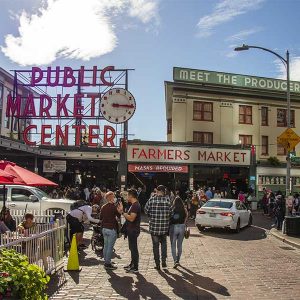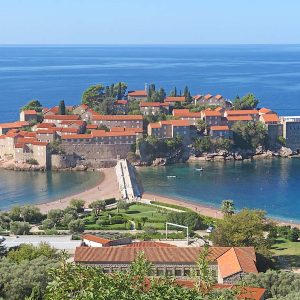May 8th, 2015 marked the seventieth anniversary of the end of the Second World War in Europe. VE day was celebrated publicly in the streets across the continent. Over 14 million lives were gravely altered for ever because of the events that occurred between 1939 and 1945. There are a number of exquisitely preserved and well exhibited reminders of the war years in northern France. A number of them are within easy reach of Calais. They present a splendid portrait of life with the Germans during WW2. Visitors from England can nip across the Channel and take a tour easily over a weekend.
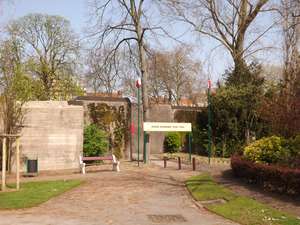 Take the ferry across and you can start off in Calais itself, right opposite the very grand town hall tower. You can see this pillar from miles away as the boat approaches the port. Go and find the beautiful Parc St. Pierre.
Take the ferry across and you can start off in Calais itself, right opposite the very grand town hall tower. You can see this pillar from miles away as the boat approaches the port. Go and find the beautiful Parc St. Pierre.
The woodland in this park provides cover for a hidden German Naval bunker that was built to last almost forever. The moss and leaf coverings on this blockhouse disguise its original purpose. It is home these days to the ‘Musee Memoire’ which presents a monument to the city’s occupation during WW2. The building maintains a series of rooms each side of a central corridor. They are probably much as they were during the war years. Each room exhibits a different theme and period. Aviation, prisoners of war, the resistance and others are all supported by many posters and original newspaper cuttings from that time. The museum also displays uniforms, weapons and machinery. They were all part of life in Calais during the Occupation. There are so many exhibits and all are so fascinating.
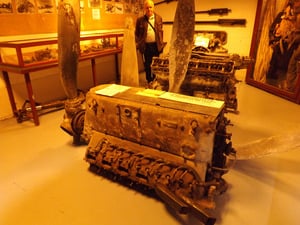 Externally, the museum bears the signs and pockmarks of original allied shelling. Nowadays it survives amongst beautiful woodland. Local people can often be seen playing petanque just outside the entrance.
Externally, the museum bears the signs and pockmarks of original allied shelling. Nowadays it survives amongst beautiful woodland. Local people can often be seen playing petanque just outside the entrance.
After your visit, head off towards the south east and locate Le Blockhaus d’Eperlecques. It lies about 10 kilometres North West of the grand town of St. Omer. The blockhouse is a massive structure built of reinforced concrete. It was constructed in 1943 by the Germans and was to be their V1 rocket launching site.
It is maintained these days by the French people as another museum and there is much for the visitor to see and wonder at. The first impression is of just how indestructible the fortification is. The tour guide provides much illumination about the war years and Occupation. There is information of how the structure was built by slave labour, prisoners of war and forced French workers. The construction was fast and dangerous and many thousands of the labourers were killed in the process.
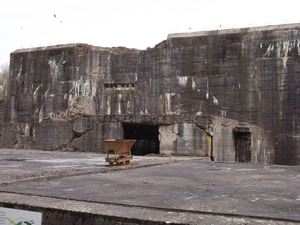 D’Eperlecques was bombed by the Allies furiously using Tallboy earthquake weapons. The damage was sufficient to prevent long term use of the V1 weapons by the Germans but a number had arrived over London. There are many exhibits from the period including one of the original V1 flying bombs on its firing rail. The direction points towards the North West. Le Blockhaus d’Eplerlecques lies amongst beautifully forested countryside that was used as camouflage from the enemy. Today, the terrain provides a wonderfully peaceful backdrop to the museum.
D’Eperlecques was bombed by the Allies furiously using Tallboy earthquake weapons. The damage was sufficient to prevent long term use of the V1 weapons by the Germans but a number had arrived over London. There are many exhibits from the period including one of the original V1 flying bombs on its firing rail. The direction points towards the North West. Le Blockhaus d’Eplerlecques lies amongst beautifully forested countryside that was used as camouflage from the enemy. Today, the terrain provides a wonderfully peaceful backdrop to the museum.
Spend your first night in one of the many inexpensive hotels within the surrounding countryside. British people are made extremely welcome due to the association with WW2 history.
Set off the next morning to visit another indestructible V weapon launching site called La Coupole. It is close by just to the south of St. Omer. Nowadays it has its very own contemporary planetarium. The experience may well be the highlight of your trip.
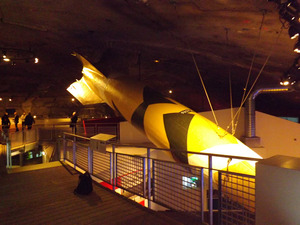 La Coupole is another huge, dense and indestructible feature built into a massive trench scraped from the surrounding rocky terrain. The Germans had intended to use it for the assembly, storage and launching site for the much more advanced and destructive V2 rocket. The only surviving V2 is exhibited in the accompanying museum. A viewing of everything else there will be fascinating and enlightening. The museum at La Coupole does not commemorate war. Rather it celebrates the early science and technology that led to human space travel. It all emerged out of the ruins of the war. The block house structure and museum is seen by the French as a monument to a modern, peaceful and stable Europe.
La Coupole is another huge, dense and indestructible feature built into a massive trench scraped from the surrounding rocky terrain. The Germans had intended to use it for the assembly, storage and launching site for the much more advanced and destructive V2 rocket. The only surviving V2 is exhibited in the accompanying museum. A viewing of everything else there will be fascinating and enlightening. The museum at La Coupole does not commemorate war. Rather it celebrates the early science and technology that led to human space travel. It all emerged out of the ruins of the war. The block house structure and museum is seen by the French as a monument to a modern, peaceful and stable Europe.
A visit to the associated planetarium will be a completely separate experience. As visitors enter the amphitheatre, they are given a pair of 3D glasses and headphones to listen to commentaries in their own language. The film shows presented celebrate spaceflight; the spaceflight that had its beginnings in northern France.
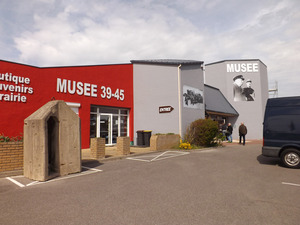 Animations include simulations of the solar system. Early and modern space travel features are presented. The moon landings are also portrayed in such realistic and almost alarming style. Viewers will instinctively duck as they watch the approaching illusions bear down on their focus. It is all very exciting and exhilarating to watch. The planetarium also is not so much about the Occupation years of World War 2; it is more about what came out of it. It is about the science that was created in Europe 70 years ago.
Animations include simulations of the solar system. Early and modern space travel features are presented. The moon landings are also portrayed in such realistic and almost alarming style. Viewers will instinctively duck as they watch the approaching illusions bear down on their focus. It is all very exciting and exhilarating to watch. The planetarium also is not so much about the Occupation years of World War 2; it is more about what came out of it. It is about the science that was created in Europe 70 years ago.
When you have seen enough of La Coupole, move on to somewhere much more conventional. It is the beautifully and pristinely presented museum at Ambleteuse, back towards the coast again, south west of Calais.
The 39-45 Musee at Ambleteuse is surely a splendid venue. It is a privately owned museum that has been built up by the French owner over 40 years of searching. It lies just off the main road going into the village. It is full to the ceilings of genuine articles of every nature gathered from the war years from across the world. The museum is a passion and a lifetime preoccupation of the owner. He will be there to meet you and show you round.
 There are collections of mannequins wearing genuine uniforms from all of the international forces that were involved in WW2. There are vast numbers of hand weapons, all made safe, tidily exhibited. There are also badges, medals, survival and escape equipment all splendidly displayed. The history of these articles is all there to see and the museum owner has an encyclopedic knowledge of everything that he has gathered over the years. There are presentations of street life exactly as it was during the war years.
There are collections of mannequins wearing genuine uniforms from all of the international forces that were involved in WW2. There are vast numbers of hand weapons, all made safe, tidily exhibited. There are also badges, medals, survival and escape equipment all splendidly displayed. The history of these articles is all there to see and the museum owner has an encyclopedic knowledge of everything that he has gathered over the years. There are presentations of street life exactly as it was during the war years.
In this museum there is also a recovered cinema just as it was during the Second World War. The cinema seats and furniture came from a genuine theatre operating at the time. Films are shown, now digital, portraying so many accounts of life during the 1940s.
The museum is truly a remarkable place to visit. All of the exhibits have been carefully traced, collected and documented. The quality of the style of the showcase cannot be overstressed. It is a work of dedication and passion by the owner.
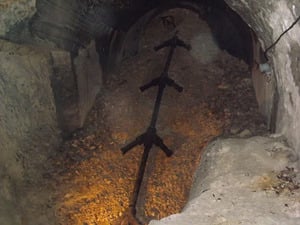 Just a very few Kilometres along the coast road towards the north, visitors can drop off at the ‘Musee de Mur de L’Atlantique’. This is another German construction of vast proportions built by slave labour during World War 2. This ‘Atlantic Wall’ museum was built to contain the most massive cannons aimed across the channel to strike London. Visitors can clamber quite safely over one of the mammoth guns has that has been perfectly preserved. It is outside the fortification pointing over the sea towards south east England.
Just a very few Kilometres along the coast road towards the north, visitors can drop off at the ‘Musee de Mur de L’Atlantique’. This is another German construction of vast proportions built by slave labour during World War 2. This ‘Atlantic Wall’ museum was built to contain the most massive cannons aimed across the channel to strike London. Visitors can clamber quite safely over one of the mammoth guns has that has been perfectly preserved. It is outside the fortification pointing over the sea towards south east England.
The massive blockhouse is maintained as a remembrance. Visitors can, with caution, wander through it at will without an escort. There are many artefacts from the war years displayed just as they were at the time. There is even a collection of discarded wine bottles. The huge guns were intended to fire a total of 800 rounds a day. The shells weighed about 800 kilograms each and would be in ‘free flight’ for about 60 seconds before they hit their target. The war ended before they had achieved any damage.
If you decide to take the visit, spend your second night very close by at La Ferm du Vert. This is a beautiful and inexpensive hotel. It has a very tranquil location along a rural French country lane.
Before returning on your last day, visit the Mimoyecques Fortress. This was a fortified German V3 weapon site and lies between the Atlantic Wall museum and Calais. The V3 weapon was never used in the end. It is an extremely long barrelled cannon that was protected by another series of concrete underground tunnels. They were also produced by many forced labourers. The work was hard and intense and many of them died during the process.
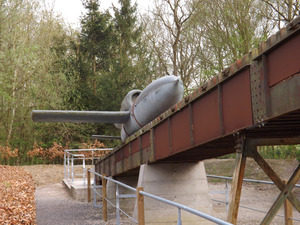 Once again, the V3 was aimed at London and the displayed exhibit still points in that direction. The main shell was loaded into the breach. It speed was then made to accelerate by 35 additional explosives as it travelled up the tube. Each of the 35 additional charges had to be loaded by slave labour to fire each main charge. The German army had intended to fire three thousand rounds a day. The work would have been dangerous and cruel. Take a look and reflect on the total disrespect that existed for human life in such recent history.
Once again, the V3 was aimed at London and the displayed exhibit still points in that direction. The main shell was loaded into the breach. It speed was then made to accelerate by 35 additional explosives as it travelled up the tube. Each of the 35 additional charges had to be loaded by slave labour to fire each main charge. The German army had intended to fire three thousand rounds a day. The work would have been dangerous and cruel. Take a look and reflect on the total disrespect that existed for human life in such recent history.
Mimoyecques is also home nowadays to 11 species of bat. The museum is closed during a few of the winter months to protect the breeding season.
As you return to Calais for your trip home, take the coastal road. On a clear day the White Cliffs of Dover can clearly be seen. Adolph Hitler and his military must have been so tempted by the sight. The country that they wanted to invade so much was so close yet ultimately unreachable.
The French government present the museums, artefacts and emplacements as a symbol of the new days of a unified Europe. A trip around them provides a very poignant reminder of perhaps relatives that may not have returned home from the war. They are a reminder of just how lucky we all are today to have not been involved in the conflict.
You may also find interesting:
- An Emotional visit to Flanders Fields
- Battlefield Tours
- Battlefield Tours – Libya & Egypt
- Coach tour to the WWI sites in Belgium and France
- Remembrance Sunday at Great Gable in the Lake District
- The 2014-2018 Great War Centenary Commemorations
- Twenty Fourteen, One Hundred Years after the Great War
- World War One – Deborah The Iron Lady



